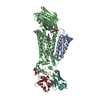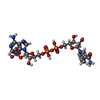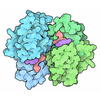[English] 日本語
 Yorodumi
Yorodumi- PDB-8wej: Structure of human phagocyte NADPH oxidase in the activated state -
+ Open data
Open data
- Basic information
Basic information
| Entry | Database: PDB / ID: 8wej | ||||||||||||
|---|---|---|---|---|---|---|---|---|---|---|---|---|---|
| Title | Structure of human phagocyte NADPH oxidase in the activated state | ||||||||||||
 Components Components |
| ||||||||||||
 Keywords Keywords | OXIDOREDUCTASE / NOX2 / p22 / CYBA / CYBB / TP1170 / NOX / p67 / Rac / p47 | ||||||||||||
| Function / homology |  Function and homology information Function and homology informationnegative regulation of glomerular filtration by angiotensin / smooth muscle hypertrophy / superoxide-generating NADPH oxidase activity / Oxidoreductases; Acting on NADH or NADPH; With oxygen as acceptor / regulation of respiratory burst involved in inflammatory response / neutrophil-mediated killing of gram-positive bacterium / superoxide-generating NADPH oxidase activator activity / positive regulation of mucus secretion / hypoxia-inducible factor-1alpha signaling pathway / cellular response to L-glutamine ...negative regulation of glomerular filtration by angiotensin / smooth muscle hypertrophy / superoxide-generating NADPH oxidase activity / Oxidoreductases; Acting on NADH or NADPH; With oxygen as acceptor / regulation of respiratory burst involved in inflammatory response / neutrophil-mediated killing of gram-positive bacterium / superoxide-generating NADPH oxidase activator activity / positive regulation of mucus secretion / hypoxia-inducible factor-1alpha signaling pathway / cellular response to L-glutamine / neutrophil-mediated killing of fungus / phagolysosome / positive regulation of toll-like receptor 2 signaling pathway / positive regulation of defense response to bacterium / mucus secretion / perinuclear endoplasmic reticulum / leukotriene metabolic process / Cross-presentation of particulate exogenous antigens (phagosomes) / cytochrome complex assembly / NADPH oxidase complex / superoxide-generating NAD(P)H oxidase activity / response to yeast / cellular response to testosterone stimulus / respiratory burst / WNT5:FZD7-mediated leishmania damping / respiratory burst involved in defense response / response to angiotensin / phosphatidylinositol-3,4-bisphosphate binding / response to aldosterone / regulation of release of sequestered calcium ion into cytosol / ROS and RNS production in phagocytes / hydrogen peroxide biosynthetic process / protein targeting to membrane / superoxide anion generation / small GTPase-mediated signal transduction / superoxide metabolic process / Detoxification of Reactive Oxygen Species / positive regulation of reactive oxygen species biosynthetic process / cellular response to cadmium ion / cellular response to ethanol / cellular response to angiotensin / tertiary granule membrane / monoatomic ion channel complex / RHO GTPases Activate NADPH Oxidases / RAC2 GTPase cycle / RAC3 GTPase cycle / cellular defense response / NADPH binding / specific granule membrane / positive regulation of superoxide anion generation / stress fiber / positive regulation of endothelial cell proliferation / RAC1 GTPase cycle / response to nutrient / positive regulation of smooth muscle cell proliferation / FAD binding / phosphatidylinositol binding / response to interleukin-1 / positive regulation of phagocytosis / secretory granule / epithelial cell proliferation / small monomeric GTPase / response to activity / response to nutrient levels / cellular response to glucose stimulus / establishment of localization in cell / cellular response to mechanical stimulus / cellular response to gamma radiation / defense response / positive regulation of interleukin-6 production / SH3 domain binding / VEGFA-VEGFR2 Pathway / cytoplasmic side of plasma membrane / phagocytic vesicle membrane / positive regulation of angiogenesis / positive regulation of tumor necrosis factor production / cellular response to tumor necrosis factor / nuclear envelope / flavin adenine dinucleotide binding / positive regulation of cell growth / monoatomic ion transmembrane transport / response to hypoxia / electron transfer activity / endosome / apical plasma membrane / response to xenobiotic stimulus / inflammatory response / protein heterodimerization activity / innate immune response / focal adhesion / neuronal cell body / GTPase activity / heme binding / dendrite / Neutrophil degranulation / endoplasmic reticulum membrane / GTP binding / metal ion binding / membrane / plasma membrane Similarity search - Function | ||||||||||||
| Biological species |  Homo sapiens (human) Homo sapiens (human) | ||||||||||||
| Method | ELECTRON MICROSCOPY / single particle reconstruction / cryo EM / Resolution: 2.79 Å | ||||||||||||
 Authors Authors | Chen, L. / Liu, X. | ||||||||||||
| Funding support |  China, 3items China, 3items
| ||||||||||||
 Citation Citation |  Journal: Nature / Year: 2024 Journal: Nature / Year: 2024Title: Structure of human phagocyte NADPH oxidase in the activated state. Authors: Xiaoyu Liu / Yiting Shi / Rui Liu / Kangcheng Song / Lei Chen /  Abstract: Phagocyte NADPH oxidase, a protein complex with a core made up of NOX2 and p22 subunits, is responsible for transferring electrons from intracellular NADPH to extracellular oxygen. This process ...Phagocyte NADPH oxidase, a protein complex with a core made up of NOX2 and p22 subunits, is responsible for transferring electrons from intracellular NADPH to extracellular oxygen. This process generates superoxide anions that are vital for killing pathogens. The activation of phagocyte NADPH oxidase requires membrane translocation and the binding of several cytosolic factors. However, the exact mechanism by which cytosolic factors bind to and activate NOX2 is not well understood. Here we present the structure of the human NOX2-p22 complex activated by fragments of three cytosolic factors: p47, p67 and Rac1. The structure reveals that the p67-Rac1 complex clamps onto the dehydrogenase domain of NOX2 and induces its contraction, which stabilizes the binding of NADPH and results in a reduction of the distance between the NADPH-binding domain and the flavin adenine dinucleotide (FAD)-binding domain. Furthermore, the dehydrogenase domain docks onto the bottom of the transmembrane domain of NOX2, which reduces the distance between FAD and the inner haem. These structural rearrangements might facilitate the efficient transfer of electrons between the redox centres in NOX2 and lead to the activation of phagocyte NADPH oxidase. | ||||||||||||
| History |
|
- Structure visualization
Structure visualization
| Structure viewer | Molecule:  Molmil Molmil Jmol/JSmol Jmol/JSmol |
|---|
- Downloads & links
Downloads & links
- Download
Download
| PDBx/mmCIF format |  8wej.cif.gz 8wej.cif.gz | 269.4 KB | Display |  PDBx/mmCIF format PDBx/mmCIF format |
|---|---|---|---|---|
| PDB format |  pdb8wej.ent.gz pdb8wej.ent.gz | 202 KB | Display |  PDB format PDB format |
| PDBx/mmJSON format |  8wej.json.gz 8wej.json.gz | Tree view |  PDBx/mmJSON format PDBx/mmJSON format | |
| Others |  Other downloads Other downloads |
-Validation report
| Summary document |  8wej_validation.pdf.gz 8wej_validation.pdf.gz | 1.7 MB | Display |  wwPDB validaton report wwPDB validaton report |
|---|---|---|---|---|
| Full document |  8wej_full_validation.pdf.gz 8wej_full_validation.pdf.gz | 1.7 MB | Display | |
| Data in XML |  8wej_validation.xml.gz 8wej_validation.xml.gz | 53.7 KB | Display | |
| Data in CIF |  8wej_validation.cif.gz 8wej_validation.cif.gz | 79 KB | Display | |
| Arichive directory |  https://data.pdbj.org/pub/pdb/validation_reports/we/8wej https://data.pdbj.org/pub/pdb/validation_reports/we/8wej ftp://data.pdbj.org/pub/pdb/validation_reports/we/8wej ftp://data.pdbj.org/pub/pdb/validation_reports/we/8wej | HTTPS FTP |
-Related structure data
| Related structure data |  37477MC  8x2lC M: map data used to model this data C: citing same article ( |
|---|---|
| Similar structure data | Similarity search - Function & homology  F&H Search F&H Search |
- Links
Links
- Assembly
Assembly
| Deposited unit | 
|
|---|---|
| 1 |
|
- Components
Components
-Cytochrome b-245 ... , 2 types, 2 molecules AB
| #1: Protein | Mass: 21005.398 Da / Num. of mol.: 1 Source method: isolated from a genetically manipulated source Source: (gene. exp.)  Homo sapiens (human) / Gene: CYBA / Production host: Homo sapiens (human) / Gene: CYBA / Production host:  Homo sapiens (human) / References: UniProt: P13498 Homo sapiens (human) / References: UniProt: P13498 |
|---|---|
| #2: Protein | Mass: 65412.727 Da / Num. of mol.: 1 Source method: isolated from a genetically manipulated source Source: (gene. exp.)  Homo sapiens (human) / Gene: CYBB / Production host: Homo sapiens (human) / Gene: CYBB / Production host:  Homo sapiens (human) / References: UniProt: P04839 Homo sapiens (human) / References: UniProt: P04839 |
-Protein , 3 types, 3 molecules CDE
| #3: Protein | Mass: 32813.297 Da / Num. of mol.: 1 Source method: isolated from a genetically manipulated source Source: (gene. exp.)  Homo sapiens (human) / Gene: NCF1 / Production host: Homo sapiens (human) / Gene: NCF1 / Production host:  Homo sapiens (human) / References: UniProt: P14598 Homo sapiens (human) / References: UniProt: P14598 |
|---|---|
| #4: Protein | Mass: 34978.535 Da / Num. of mol.: 1 Source method: isolated from a genetically manipulated source Source: (gene. exp.)  Homo sapiens (human) / Gene: NCF2 / Production host: Homo sapiens (human) / Gene: NCF2 / Production host:  Homo sapiens (human) / References: UniProt: A0A024R936 Homo sapiens (human) / References: UniProt: A0A024R936 |
| #5: Protein | Mass: 21463.143 Da / Num. of mol.: 1 Source method: isolated from a genetically manipulated source Source: (gene. exp.)  Homo sapiens (human) / Gene: RAC1 / Production host: Homo sapiens (human) / Gene: RAC1 / Production host:  Homo sapiens (human) / References: UniProt: A0A8C8XFZ1 Homo sapiens (human) / References: UniProt: A0A8C8XFZ1 |
-Antibody , 2 types, 2 molecules HL
| #6: Antibody | Mass: 27603.949 Da / Num. of mol.: 1 Source method: isolated from a genetically manipulated source Source: (gene. exp.)   |
|---|---|
| #7: Antibody | Mass: 26238.188 Da / Num. of mol.: 1 Source method: isolated from a genetically manipulated source Source: (gene. exp.)   |
-Sugars , 2 types, 3 molecules 
| #8: Polysaccharide | beta-D-mannopyranose-(1-4)-2-acetamido-2-deoxy-beta-D-glucopyranose-(1-4)-2-acetamido-2-deoxy-beta- ...beta-D-mannopyranose-(1-4)-2-acetamido-2-deoxy-beta-D-glucopyranose-(1-4)-2-acetamido-2-deoxy-beta-D-glucopyranose Source method: isolated from a genetically manipulated source |
|---|---|
| #10: Sugar |
-Non-polymers , 6 types, 8 molecules 










| #9: Chemical | | #11: Chemical | #12: Chemical | ChemComp-NDP / | #13: Chemical | ChemComp-FDA / | #14: Chemical | ChemComp-GTP / | #15: Water | ChemComp-HOH / | |
|---|
-Details
| Has ligand of interest | N |
|---|---|
| Has protein modification | Y |
-Experimental details
-Experiment
| Experiment | Method: ELECTRON MICROSCOPY |
|---|---|
| EM experiment | Aggregation state: PARTICLE / 3D reconstruction method: single particle reconstruction |
- Sample preparation
Sample preparation
| Component | Name: activated NOX2-p22 complex / Type: COMPLEX / Entity ID: #1-#7 / Source: RECOMBINANT |
|---|---|
| Source (natural) | Organism:  Homo sapiens (human) Homo sapiens (human) |
| Source (recombinant) | Organism:  Homo sapiens (human) Homo sapiens (human) |
| Buffer solution | pH: 7.5 |
| Specimen | Embedding applied: NO / Shadowing applied: NO / Staining applied: NO / Vitrification applied: YES |
| Vitrification | Cryogen name: ETHANE |
- Electron microscopy imaging
Electron microscopy imaging
| Experimental equipment |  Model: Titan Krios / Image courtesy: FEI Company |
|---|---|
| Microscopy | Model: FEI TITAN KRIOS |
| Electron gun | Electron source:  FIELD EMISSION GUN / Accelerating voltage: 300 kV / Illumination mode: FLOOD BEAM FIELD EMISSION GUN / Accelerating voltage: 300 kV / Illumination mode: FLOOD BEAM |
| Electron lens | Mode: BRIGHT FIELD / Nominal defocus max: 1800 nm / Nominal defocus min: 1500 nm |
| Image recording | Electron dose: 52 e/Å2 / Film or detector model: GATAN K3 (6k x 4k) |
- Processing
Processing
| CTF correction | Type: NONE |
|---|---|
| 3D reconstruction | Resolution: 2.79 Å / Resolution method: FSC 0.143 CUT-OFF / Num. of particles: 209359 / Symmetry type: POINT |
 Movie
Movie Controller
Controller



 PDBj
PDBj



















